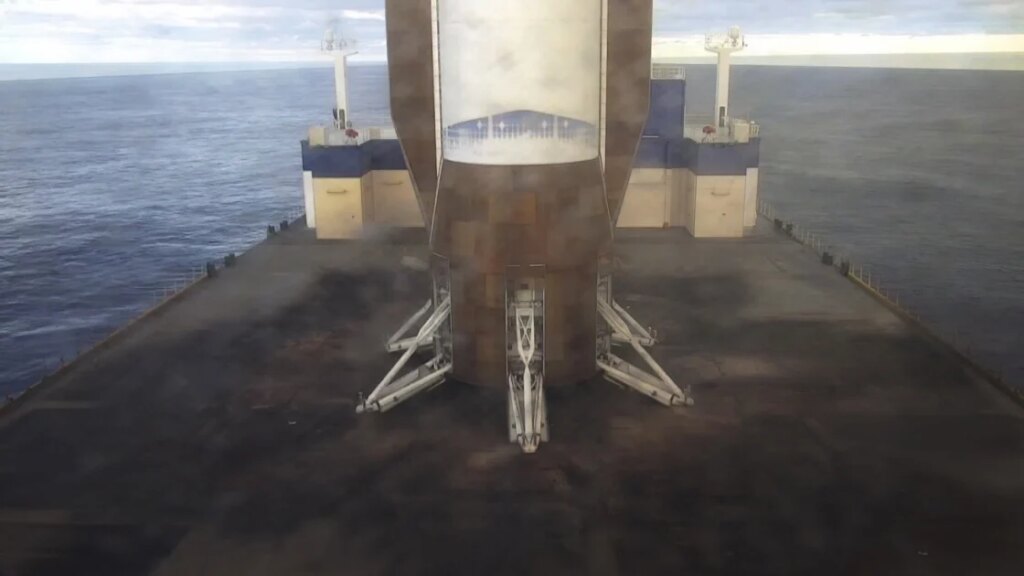On its second launch, Blue Origin’s New Glenn rocket started a pair of NASA probes on a journey to Mars, and had its booster finish its own flight by landing on a barge in the Atlantic Ocean.
That first-stage recovery, something that eluded New Glenn on its Jan. 16 debut, puts the flagship rocket of Jeff Bezos’ space enterprise in rare company.
SpaceX’s Falcon 9 and Falcon Heavy are the only other orbital rockets to have landed boosters intact. And while Elon Musk’s much larger space company has made powered landings a routine sight along Florida’s Space Coast, SpaceX needed three tries to land a Falcon 9 booster after its first four years of flying Falcon 9.
The mission lifted off from Launch Complex 36 at Cape Canaveral Space Force Station at 3:55 p.m. Thursday, a delay after a hold called with 20 seconds left before the first planned launch time. The booster’s seven BE-4 methane-fueled engines slowly lifted it off the pad, then accelerated it through the afternoon sky.
New Glenn, moments after leaving the Earth. (Credit: Blue Origin)
After staging, the first stage—nicknamed “Never Tell Me the Odds”—completed a re-entry burn and then performed a remarkable bit of flying as it neared the landing barge Jacklyn, named after Bezos’ mother.
As video shared on Blue Origin’s webcast on YouTube showed (with one brief “buffering” error), the booster slowed above the water and then flew almost sideways over to the center of the landing surface 375 miles offshore to touch down on six landing legs.
This Tweet is currently unavailable. It might be loading or has been removed.
Meanwhile, the two BE-3U hydrogen-fueled engines in New Glenn’s second stage continued a climb to orbit, after which a second burn sent the mission’s primary payload—two small Mars probes built for NASA by Rocket Lab—on the start of a lengthy voyage to the Red Planet.
The space agency paid a bargain price for this launch of the two ESCAPADE (Escape and Plasma Acceleration and Dynamics Explorers) spacecraft—just $20 million, a discount reflecting New Glenn’s unproven status when NASA inked that deal in 2023.
Get Our Best Stories!
Your Daily Dose of Our Top Tech News
Sign up for our What’s New Now newsletter to receive the latest news, best new products, and expert advice from the editors of PCMag.
Sign up for our What’s New Now newsletter to receive the latest news, best new products, and expert advice from the editors of PCMag.
By clicking Sign Me Up, you confirm you are 16+ and agree to our Terms of Use and Privacy Policy.
Thanks for signing up!
Your subscription has been confirmed. Keep an eye on your inbox!
Thursday’s mission represented a dramatic step forward in Blue Origin’s capability from its single-stage, suborbital New Shepard rocket. Until January, that reusable vehicle, which launches and lands from facilities in West Texas, had been Blue’s only machine to reach space.
Acting NASA administrator Sean Duffy accordingly commended Blue’s work on X and Musk posted his own congratulations. President Trump’s renominated pick for NASA administrator, Jared Isaacman, did the same, writing “Damn that was exciting!”
New Glenn has much work in store: Amazon’s Project Kuiper low-Earth-orbit broadband satellite constellation, just renamed Amazon Leo, has at least 12 New Glenn flights booked as part of a massive launch order announced in 2022. And AST SpaceMobile will take advantage of New Glenn’s capacity—almost 50 tons to low Earth orbit and 14 tons to geostationary orbit—to launch some of its large BlueBird broadband satellites.
Recommended by Our Editors
Nowhere to go but up. (Credit: Blue Origin)
But as the “Next stop, Moon!” cheering of Blue employees on the launch video should indicate, the most important cargo pending for New Glenn is the series of lunar landers that the company is building for NASA.
Sometime next year, Blue Origin plans to fly its Blue Moon Mark 1 cargo-only lander on New Glenn (named after John Glenn, the first American to orbit the Earth). Blue has been planning to follow that lunar vehicle with a much larger, crewed version, Blue Moon Mark 2, that it’s been developing for NASA under a $3.4 billion contract for its Artemis moon project.
That 2023 award came two years after NASA signed a $2.89 billion contract with SpaceX for a lunar lander based on the upper stage of that company’s giant Starship rocket, which has now had 11 test flights but has yet to reach orbit, much less demonstrate the in-orbit refueling required for SpaceX’s concept to work.
That lagging progress led Duffy to announce in October that he was reopening the contract to build a human landing system for Artemis III, the mission intended to return American astronauts to the Moon for the first time since 1972. Blue is now reportedly working on a crew-capable version of Blue Moon Mark 1 that could fly sooner, while SpaceX announced that has presented NASA with a “simplified” version of its Starship-based lander.
Thursday’s successful launch makes this space race even more interesting.
About Our Expert
Experience
Rob Pegoraro writes about interesting problems and possibilities in computers, gadgets, apps, services, telecom, and other things that beep or blink. He’s covered such developments as the evolution of the cell phone from 1G to 5G, the fall and rise of Apple, Google’s growth from obscure Yahoo rival to verb status, and the transformation of social media from CompuServe forums to Facebook’s billions of users. Pegoraro has met most of the founders of the internet and once received a single-word email reply from Steve Jobs.
Read Full Bio

